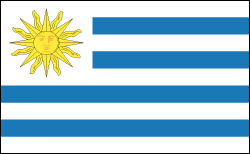URUGUAY

Geography: Uruguay, on the east coast of South America south of Brazil and east of Argentina, is comparable in size to Oklahoma. The country consists of a low, rolling plain in the south and a low plateau in the north. It has a 120-mile (193 km) Atlantic shoreline, a 235-mile (378 km) frontage on the Rio de la Plata, and 270 mi (435 km) on the Uruguay River, its western boundary.
Government: Constitutional republic.
History: Prior to European settlement, Uruguay was inhabited by indigenous people, the Charrúas. Juan Díaz de Solis, a Spaniard, visited Uruguay in 1516, but the Portuguese were first to settle it when they founded the town of Colonia del Sacramento in 1680. After a long struggle, Spain wrested the country from Portugal in 1778, by which time almost all of the indigenous people had been exterminated. Uruguay revolted against Spain in 1811, only to be conquered in 1817 by the Portuguese from Brazil. Independence was reasserted with Argentine help in 1825, and the republic was set up in 1828.
A revolt in 1836 touched off nearly 50 years of factional strife, including an inconclusive civil war (1839–1851) and a war with Paraguay (1865–1870), accompanied by occasional armed intervention by Argentina and Brazil. Uruguay, made prosperous by meat and wool exports, founded a welfare state early in the 20th century under President José Batlle y Ordóñez, who ruled from 1903 to 1929. A decline began in the 1950s as successive governments struggled to maintain a large bureaucracy and costly social benefits. Economic stagnation and left-wing terrorist activity followed.
Government: Constitutional republic.
History: Prior to European settlement, Uruguay was inhabited by indigenous people, the Charrúas. Juan Díaz de Solis, a Spaniard, visited Uruguay in 1516, but the Portuguese were first to settle it when they founded the town of Colonia del Sacramento in 1680. After a long struggle, Spain wrested the country from Portugal in 1778, by which time almost all of the indigenous people had been exterminated. Uruguay revolted against Spain in 1811, only to be conquered in 1817 by the Portuguese from Brazil. Independence was reasserted with Argentine help in 1825, and the republic was set up in 1828.
A revolt in 1836 touched off nearly 50 years of factional strife, including an inconclusive civil war (1839–1851) and a war with Paraguay (1865–1870), accompanied by occasional armed intervention by Argentina and Brazil. Uruguay, made prosperous by meat and wool exports, founded a welfare state early in the 20th century under President José Batlle y Ordóñez, who ruled from 1903 to 1929. A decline began in the 1950s as successive governments struggled to maintain a large bureaucracy and costly social benefits. Economic stagnation and left-wing terrorist activity followed.

Map of Uruguay
President: Tabaré Vázquez
(2015)
Land area: 67,035 sq mi (173,621 sq km);
total area: 68,039 sq mi (176,220 sq km)
Population (2014 est.): 3,332,972 (growth
rate: 0.26%); birth rate: 13.18/1000; infant mortality rate: 8.97/1000;
life expectancy: 76.81; density per sq mi: 48.86
Capital and largest city (2011 est.):
Montevideo, 1,947,604 (metro. area), 1,305,082
(city proper)
Monetary unit: Uruguay
peso
Oriental Republic of Uruguay
National name: República Oriental del
Uruguay
Languages:
Spanish, Portunol, or Brazilero
Ethnicity/race:
white 88%, mestizo 8%, black 4%
Religions:
Roman Catholic 47.1%, Protestant 11.1%, Jewish
0.3%
Literacy rate: 98.1% (2010
est.)
Economic summary: GDP/PPP
(2013 est.): $56.27 billion; per capita $16,600. Real growth
rate: 3.5%. Inflation: 8.3%. Unemployment: 6.5%.
Arable land: 10.25%. Agriculture: soybeans, rice, wheat; beef, dairy products; fish; lumber, cellulose. Labor force (2013 est.): 1.7 million; agriculture 13%,
industry 14%, services 73%. Industries: food processing,
electrical machinery, transportation equipment, petroleum products,
textiles, chemicals, beverages. Natural resources: arable land,
hydropower, minor minerals, fish. Exports: $10.5 billion
(2013 est.): beef, soybeans, cellulose, rice, wheat, wood, dairy products; wool. Imports:
$12.5 billion (2013 est.): refined oil, crude oil, passenger and other
transportation vehicles, vehicle parts, cellular phones. Major trading partners:
U.S., Brazil, Germany, Argentina, Paraguay, China, Venezuela (2012).
Communications: Telephones: main lines
in use: 1.01 million (2012); mobile cellular: 5 million (2012). Radio
broadcast stations: AM 91, FM 149, shortwave 7 (2010). Radios:
1.97 million (1997). Television broadcast stations: 20
(2010). Televisions: 782,000 (1997). Internet Service
Providers (ISPs): 1.036 million (2012). Internet users: 1.405 million
(2009).
Transportation: Railways:
total: 1,641 km (2010). Highways: total: 77,732 km; paved: 7,743
km; unpaved: 69,989 km (2010 est.). Waterways: 1,600 km; used by
coastal and shallow-draft river craft (2011). Ports and harbors:
Colonia, Fray Bentos, Juan La Caze, La Paloma, Montevideo, Nueva
Palmira, Paysandu, Punta del Este, Piriapolis. Airports: 133
(2013).
International disputes:
in 2010, the ICJ ruled in favor of Uruguay's operation of two paper
mills on the Uruguay River, which forms the border with Argentina; the
two countries formed a joint pollution monitoring regime; uncontested
boundary dispute between Brazil and Uruguay over Braziliera/Brasiliera
Island in the Quarai/Cuareim River leaves the tripoint with Argentina in
question; smuggling of firearms and narcotics continues to be an issue
along the Uruguay-Brazil border.
-------------------- o --------------------
No comments:
Post a Comment